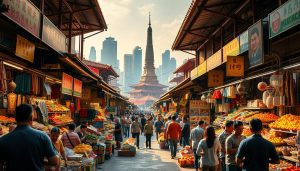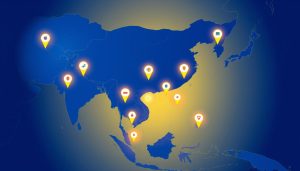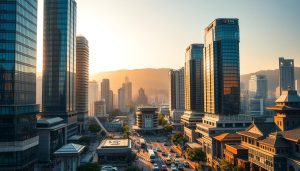The dynamic Asian markets are key in the latest business trends. They show how 20% of global trade involves partnerships across big distances. The growth of these markets is impressive, with countries like Vietnam and Indonesia seeing huge increases in trade with China.
Vietnam’s imports from China have grown by $50 billion from 2017 to 2023. Indonesia’s trade with China has also increased, from $77.3 billion to $139.4 billion. These numbers show how Asian markets are changing global trade.
In India, foreign direct investment (FDI) has risen by 26% in Q1 2024. This shows a renewed confidence in India’s economy. The number of global capability centres in India is expected to grow from 1,600 to 2,500 by 2030.
But, there’s a challenge: a $60 billion infrastructure investment gap in Southeast Asia. This gap could affect future trade. By 2035, AI systems will be as good as humans at automation and data processing. This will change industries fast.
77% of Asian apparel companies are now selling directly to consumers. This shows how fast these markets are adapting. Looking ahead, sustainability is becoming more important. Clean energy investments in ASEAN countries are expected to rise by 2035.
Young people in the Asia Pacific are also choosing sustainable products. The generative AI market in Asia is set to grow from 2023. These trends are changing not just Asian markets but the global economy too.
Geopolitical Shifts Shaping Trade and Investment
International commerce is changing fast, thanks to rising tensions in trade. These tensions are reshaping global alliances and making supply chains more resilient. They also lead to important changes in how trade patterns work, affecting economies worldwide.
The Influence of Geopolitical Tensions on Trade Patterns
Trade patterns have changed a lot recently, mainly because of tensions between big economies. The Regional Economic Partnership (RCEP) shows how Asia is becoming more united economically. In 2022, Asia’s trade within itself was about 57% of its total trade, up from 54% in 2000.
The ASEAN region’s trade with China has grown a lot, showing how politics affects trade. From 2010 to 2023, ASEAN’s trade with China went from 10% to 15% of China’s total trade. China’s share in ASEAN’s trade also rose, from 12% to 20%. This change is a big response to geopolitical tensions.
Reconfiguring Supply Chains for Geopolitical Resilience
Strong geopolitical winds are making companies and countries rethink their supply chains. They want to be more independent and secure. The US-China trade war has made them think hard about their strategies, showing the need for resilience.
Asia’s growing economy is leading to big changes in trade and supply chains. It’s where two-thirds of global growth happens and it has 40% of global GDP. Moves like TSMC setting up outside China and Asia’s middle class growing to nearly 2.3 billion by 2030 show big changes in global trade.
These changes show a world where politics and economics are closely linked. They shape not just today’s trade but also the future of global economics.
The Quest for Supply Chain Resilience
In today’s world, having strong supply chains is key. The COVID-19 pandemic and other issues have shown us why. Companies are now looking to spread out their supply chains, focusing on high-value goods like semiconductors.
Diversifying supply chains helps companies face risks better. By working in different places, they can handle problems in one area without affecting the whole chain. This is very important for semiconductors, where politics and trade rules play big roles.
Asian countries are working hard to make more semiconductors and other important goods. They want to be less dependent on others and keep their economies strong. This is a big step towards making their supply chains more secure.
- China, Japan, and South Korea are investing more in making semiconductors. They want to be less reliant on others for these key parts.
- Asian companies are looking for new partners and routes, like the Asia-Europe path. This could change how goods move around the world.
- More companies are moving their operations closer to home, in places like Mexico and India. This makes supply chains more flexible and ready for new challenges.
This effort to strengthen supply chains is vital for keeping goods flowing. As these plans grow, businesses can stay strong and help their local economies grow too.
The strength of supply chains comes from their ability to change and grow. By making these networks better, we help businesses stay strong and support economic growth.
Strengthening Skills for Future Growth
Asia is becoming a major economic force. It’s focusing on STEM education to lead in innovation and grow its talent pool. This is key for keeping growth going.
The region’s growing role in global trade and tech is linked to its skilled workforce. This workforce is mainly in science, technology, engineering, and mathematics (STEM) fields.
Many Asian countries are now leading in STEM graduates. This puts them ahead in innovation. STEM education boosts individual skills and makes Asian economies more competitive worldwide.
This focus is growing a strong talent pool. It’s vital for fast-changing industries thanks to new tech.
For example, India’s working-age population will grow by 179 million by 2045. Many of these new workers will know STEM. This means more innovation in Asia.
These new workers offer a big chance to grow in digital marketing, e-commerce, and high-tech manufacturing. These areas are key for the future economy.
Programmes like India’s Skill India Mission and Singapore’s SkillsFuture are great. They aim to close the skills gap by improving education and training. These efforts are essential for preparing workers for new tech like automation and AI.
It’s clear that STEM education is vital for Asia’s talent pool growth. It’s preparing the region to meet and exceed future demands in innovation and tech.
Emerging Business Trends in Asia
Asia is set to change the world’s economy, with a predicted 60% of global growth by 2030. Its markets are growing fast, thanks to new technologies and smart supply chains. This growth is making Asia a key player in the world’s economy.
Asia’s trade is huge, making up 53% of global goods trade. It’s at the heart of 49 of the top 80 trade routes. This shows Asia’s big role in global trade and its influence on the world’s economy.
Asia’s population is 59% of the world’s, with a growing middle class. This is changing how people spend their money. Now, more money is spent on basic goods and special treats.
Asia is leading in technology, with Fintech set to beat North America by 2030. The region is also leading in global IPOs, with India shining. But, Asia is underrepresented in global financial indices, showing a big opportunity for investment.
Companies are diversifying their supply chains, thanks to the ‘China Plus One’ policy. New trade routes are opening, connecting Asia to places like Brazil and the Middle East.
Asia’s manufacturing is growing, led by Japan, China, and India. Countries like Vietnam, Indonesia, and Thailand are also playing big roles. Asia is key in making consumer electronics, industrial electronics, and semiconductors.
- Expansion of the EV sector with companies like BYD and Geely revitalising regional manufacturing.
- Growth of services, with India’s global capability centres set to see huge revenue growth by 2030.
- Adoption of new technologies, ahead of Western countries, boosting productivity and market response.
Asia’s R&D sector spends 51% of global R&D and has 87% of patents. It’s leading in fintech, digital banking, and telecommunications. This is changing how businesses and consumers work together, creating a fast-changing market.
We’re seeing a new era of growth and innovation in Asia. It’s a place of great economic opportunity. Asia shows how flexibility, planning, and technology can drive big market growth and change.
Digital Transformation Accelerating Progress
Asia is leading in digital transformation, thanks to big investments and tech innovations. Businesses here are using cloud computing and AI to improve operations and engage with customers better. The growth in e-commerce shows how connected and tech-savvy consumers are becoming.
Big money is going into tech infrastructure. For example, Microsoft is putting USD 1.7 billion in Jakarta and USD 2.2 billion in Malaysia for cloud and AI. These funds are key for building strong digital systems for various sectors.
New data centers are also being built. Microsoft is working with the Thai government, and Bitera is setting up in Indonesia. EDGE DC is creating green data centers, showing Asia’s focus on sustainable tech.
The e-commerce sector in Asia is booming. Digital improvements make online shopping smooth and tailored, thanks to AI. This growth is driven by better online services and data analysis.
Recent rankings show Singapore, Australia, and South Korea leading in digital transformation. They are praised for their digital infrastructure, innovation, and literacy. These factors are vital for a strong digital economy.
As we move forward, building digital trust is key. We need good policies, private sector support, and global cooperation. These are essential for growth and ensuring digital benefits for everyone.
The mix of cloud computing, AI, and e-commerce is changing how businesses work in Asia. It’s setting the stage for a future driven by digital innovation and economic growth.
Sustainability at the Core of Business Strategies
In recent years, a strong focus on sustainability has grown across Asia. This focus not only helps the environment but also makes businesses more viable in the long run. Companies in Southeast Asia are leading the way in making sustainability a key part of their plans.
Singapore aims to cut its emissions in half by 2050 and reach net-zero by then. This shows a big commitment to reducing carbon emissions. Malaysia’s palm oil industry has also started using sustainable certification to stop deforestation. This shows how protecting nature is becoming a big part of business plans.
- Transparency is being increased to fight greenwashing, with Malaysia’s Securities Commission setting strict ESG disclosure rules.
- In Vietnam, VinaCapital is working to cut emissions by making supply chains more efficient.
- Thailand’s CP Group is getting its employees involved in sustainability projects. This links their work to environmental goals, making them more committed.
Technology is also playing a big role. Singapore is using AI to manage energy in hotels, making it more efficient. This sets a good example for other industries.
- Thai farms are using water-saving methods like drip irrigation to deal with water shortages.
- Singapore Exchange is making sure companies report on their environmental impact, following TCFD guidelines.
- In Indonesia, the Re-Loop program is turning plastic waste into new products, promoting a circular economy.
The push for sustainability is changing how businesses work. It’s pushing for circular economies and using AI to save energy. This not only helps the environment but also boosts the economy by making businesses more sustainable. It keeps Asia at the forefront of global sustainability efforts.
Developing Smart Cities through Tech Innovations
In today’s world, making smart cities is key for better urban living. We use the Internet of Things (IoT) and Artificial Intelligence (AI) to improve cities. These techs help make cities more efficient and better places to live.
Smart cities use data to manage and improve life. For example, they monitor air and water quality to keep the environment clean. In Thailand, weather stations and satellite data help with this.
They also make government work better. Platforms like data.go.th make it easier to get services. This makes life in the city better for everyone.
Smart cities also improve how we move around. They use sensors to reduce traffic jams and pollution. Plus, they manage energy use with smart meters and IoT devices.
But, there are challenges. Keeping data safe and building strong digital systems are big tasks. Finding money for these projects is also hard. But, partnerships and new funding ideas can help.
Technology in cities is not just about being efficient. It’s about making cities strong and sustainable for the future. AI and IoT help make cities better places to live, now and for generations to come.
The Rise of Fintech and Digital Banking
Fintech and digital banking are changing the financial world in Asia. They bring new ideas and make things easier for everyone. This change is making finance more accessible and improving how we use technology.
Many people in Southeast Asia don’t have bank accounts. But fintech is helping to change this. Companies like GCash in the Philippines and Paytm in India are making banking available to more people. They’re not just giving access; they’re creating a fair financial system.
- Companies are focusing on new products and working together. This is helping digital finance grow.
- Apps that include banking services are making life easier for users.
- Payments and banking across borders are getting better and faster.
But, there’s a big problem with security. The APAC region faces a lot of cyberattacks. Only a few companies are focusing on keeping data safe. We need to do more to protect our information.
Having clear rules is also important for fintech. Changes in rules have helped businesses grow. This is key for digital banking to succeed.
Digital payments in Asia are growing fast. They’re expected to hit USD 1.2 trillion by 2025. Partnerships and investments are driving this growth. For example, HSBC is working with the Thai Fintech Association and investing in startups.
Looking ahead, new technologies like AI will change banking. They could add USD 200 billion to USD 340 billion in value. This shows fintech’s huge impact on finance in Asia and worldwide.
In summary, fintech and digital banking are changing finance in Asia. They’re making services better and reaching more people. With technology, innovation, and good rules, Asia is building a brighter financial future.
Flexible Work Arrangements Redefining Workplaces
The world of work is changing fast, with more people working remotely. This shift is making old ideas about workspaces outdated. Now, people want jobs that fit their lives better, not the other way around.
Remote work is changing how companies work together. They need new tools to keep everyone connected. Offices are now places for both solo work and team projects.
A survey by Unispace WorkReady shows offices are changing. They’re now places for focused work, not just team meetings. This means offices are adapting to a mix of in-person and remote work.
Soon, Singapore will have new rules for flexible work. Companies need to get ready. They must check if their systems and spaces can handle flexible work.
Testing flexible work models is a smart move. It lets companies see what works and what doesn’t. This way, they can find the right mix of remote and in-office work.
Workers in Singapore spend a lot of time in different places. This shows that flexible work is possible and good. It’s also important for older workers who are staying in the job market.
This change in work management is big. It’s not just about new tech. It’s about making workspaces that inspire and support a diverse team. As we move forward, we should focus on creating places that are both productive and uplifting.
Breakthroughs in Healthtech and Telemedicine
In the UK, we’re seeing big changes in HealthTech and telemedicine. This mix of tech and care is changing how we get healthcare. It’s making services more available and efficient.
Telemedicine is becoming more popular in Southeast Asia. Companies like Doctor Anywhere, Halodoc, and MyDoc are leading the way. They’re growing their user base and improving healthcare with new ideas.
- Wearable health devices and personal monitoring tech are growing fast. This is thanks to better sensors, AI, and data analysis.
- AI and machine learning in healthcare are getting a lot of attention. They’re used in things like imaging and predicting health trends.
Singapore is a leader in HealthTech, thanks to its strong rules and support for innovation. Malaysia is also making a mark, focusing on making medical devices.
- Thailand is boosting HealthTech and medical devices with special zones and incentives.
- Indonesia is working to make healthcare more accessible through its National Health Insurance program.
Government support and regulatory sandboxes help the sector grow. For example, Singapore’s HealthTech Regulatory Sandbox makes it easier to bring in new tech.
Digital health, including telemedicine and digital treatments, is getting more popular. There’s a growing need for advanced imaging and AI in diagnosis.
AI is also improving predictive analytics in healthcare. This leads to quicker decisions and less risk. It’s putting HealthTech at the heart of medical innovation. Companies like Doctor Anywhere and Ping An Good Doctor are leading the way with AI in telemedicine.
The Growth of New and Renewable Energy Opportunities
The rapid growth of renewable energy opportunities in Asia marks a big shift towards sustainable development. This is thanks to strong green technology investment and big steps in the energy transition in Asia. Asia’s influence is not just big; it’s changing the global energy scene.
Asia’s Role in the Global Energy Transition
Asia is set to be a key player in the global energy markets. It’s expected that renewable energy will make up 66% of the energy mix by 2050. Countries like Vietnam have seen a huge jump in solar power, with over 18 GW in 2023.
They’re now focusing on both big solar farms and rooftop solar. New ideas like floating solar farms and better energy storage are becoming more common, mainly in Southeast Asia.
Investment in Green Technologies and Renewable Energy Sources
The push for renewable energy is getting a big boost from investments. In ASEAN, clean energy investments are expected to hit $1.5 trillion by 2035. This money is helping grow solar and wind power and also supporting new green tech.
Big players like the World Bank and the Asian Development Bank are helping by funding renewable energy projects across the region.
Looking at these trends gives us a clear picture of Asia’s economic and environmental impact. It’s clear Asia is not just following; it’s leading the way to a greener, more sustainable future.
Shifting towards High-Value Services in International Trade
In recent years, the ASEAN region has seen a big change. It’s moving towards high-value services in international trade. This change focuses on areas like high-tech manufacturing, sustainable development, and digital services. It matches global trends and what consumers want.
The manufacturing sector is changing. It used to focus on textiles and basic goods. Now, it’s moving to high-tech items like electronics, semiconductors, and pharmaceuticals. Big names like Samsung, Apple, and Intel are leading this change. They’ve set up big production and R&D bases in Vietnam, Malaysia, and Indonesia.
- The region’s GDP is growing fast, with a forecast of 4.6% in 2024. This is much higher than the global average.
- Vietnam stands out, with its exports as a percentage of GDP rising from 54.2% in 2010 to 93.8% in 2022. It’s now focusing on high-value exports.
- The digital economy is also growing fast. Its gross merchandise value is expected to jump from USD218 billion in 2023 to USD600 billion by 2030. This growth is driven by e-commerce and digital financial services.
Sustainability and green value chains are key now. ASEAN nations are working to grow in a way that’s good for the planet. This move supports global efforts to reach net-zero and opens up new markets for green technologies and services.
With these changes, Southeast Asia is set to become a major player in the global economy. It aims to be the fourth largest economy by 2030. Our work on high-value services is changing our economy. It ensures we grow and stay strong in a competitive world.
Enhancing Capabilities in Advanced Manufacturing
In Asia, we’re working hard to lead in high-tech industries. We’re using new technologies like robotics, Artificial Intelligence (AI), rapid prototyping, and blockchain. These tools make us more efficient and innovative.
Investing in these technologies boosts our work quality. It puts Asia at the top of advanced manufacturing. For example, China is always ranked high in the Asia Manufacturing Index. This shows our big progress and commitment to leading.
Adoption of Robotics and Artificial Intelligence in Production Processes
In Asia, countries like Japan and South Korea are leading in innovation. They use robotics and AI to make production better. These systems are key in places where accuracy is very important.
They help solve tough manufacturing problems. They also make work easier for people and increase productivity.
Impact of Rapid Prototyping and Blockchain on Supply Chains
Rapid prototyping changes how we make and test new products. It makes the process faster and cheaper. This is key for staying ahead globally.
Blockchain adds more safety and clearness to supply chains. It’s very important for industries that need to prove where things come from. This makes our manufacturing sector strong and ready for the future.
Looking at specific plans, India and Indonesia are pushing for advanced manufacturing. Their strategies focus on key areas. They aim to improve our manufacturing to meet today’s and tomorrow’s needs.
As we move forward, Asia’s manufacturing scene looks very promising. It’s driven by a strong will to grow and excel in advanced manufacturing.
Asia’s Pivot to Green Finance and ESG Practices
Asia is changing fast towards green finance and ESG practices. This shows a strong commitment to growing in a sustainable way. Companies are now following global standards like ISSB for better ESG reporting.
This move makes them more competitive worldwide. It also helps them get more sustainable finance, drawing in more investors.
But, businesses face some hurdles. They need to collect data, deal with high costs, and keep up with changing rules. Yet, the benefits are big, like a better reputation and better sustainability scores.
- Development of new taxonomies: With over 50 official taxonomies for green finance in Asia, there is a vital need for harmonization to prevent market fragmentation and enhance the consistency of sustainable finance.
- Creating a supportive ecosystem: Recommendations to establish centralized hubs for ESG reporting can significantly reduce the burden on individual companies by streamlining processes and providing necessary tools and expertise.
- Facilitating a just transition: It’s important to consider the social and economic effects of moving to sustainable practices. We must make sure all sectors and communities are part of this change.
Asia is also focusing on renewable energy investments. Countries like Australia are leading the way. They’re working on green technologies and big renewable energy projects.
These efforts help the environment and create economic growth. They also help countries work together across the continent.
- Collaboration on renewable energy projects: Working together on renewable energy projects can speed up Asia’s energy shift. It will also help more sustainable technologies get used.
- Investment in green technology innovation: More support for green tech innovation, like Singapore’s efforts to train ESG experts, will boost new tech and its use.
By going for green finance and ESG practices, Asia is on track to meet its environmental goals. It’s also set to be a leader in the move towards a sustainable future.
Embracing Technological Leadership in the Next Decade
Looking ahead to 2040, Asia’s economy will be a key player globally. It’s expected to make up 42% of the world’s GDP. Also, 60% of the world’s biggest companies will be based here.
With 470 million new workers, Asia will be full of fresh ideas. We’re investing $140 trillion by 2030. This is more than the US and Europe combined.
Asia is leading the tech revolution, holding 75.2% of AI patents in 2022. AI investment will jump to $110 billion by 2028. This shows our drive to lead in key areas.
We’re working on digital projects like the Digital Silk Road. By 2025, 60% of AI models will be tailored for local markets. This will improve customer service, a big focus in China.
We’re combining human skills with tech. Hybrid teams are key for the future. But, digital changes might upset some teams at first.
So, we’re making our workforce flexible and investing wisely. The growing middle class and new tech companies offer many opportunities. We’re ready to seize them.
Related posts:
 Top Reasons to Do Business in Asia
Top Reasons to Do Business in Asia  Advantages of Doing Business in Hong Kong
Advantages of Doing Business in Hong Kong  Advantages of Doing Business in Japan
Advantages of Doing Business in Japan  Advantages of Doing Business in Taiwan
Advantages of Doing Business in Taiwan  Advantages of Doing Business in Vietnam
Advantages of Doing Business in Vietnam  10 Top Markets for Expanding into Asia 2026
10 Top Markets for Expanding into Asia 2026  Top 10 Reasons to Do Business in Singapore
Top 10 Reasons to Do Business in Singapore  Asia is becoming a top place for business growth
Asia is becoming a top place for business growth  Singapore’s Low Tax & Easy Company Setup
Singapore’s Low Tax & Easy Company Setup  Southeast Asian Markets Continue to Gain Prominence
Southeast Asian Markets Continue to Gain Prominence





